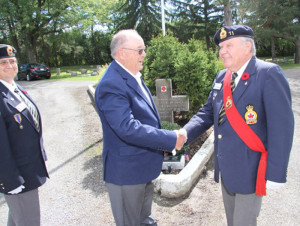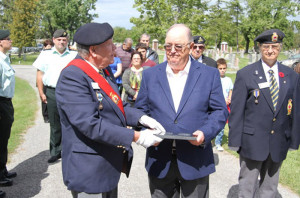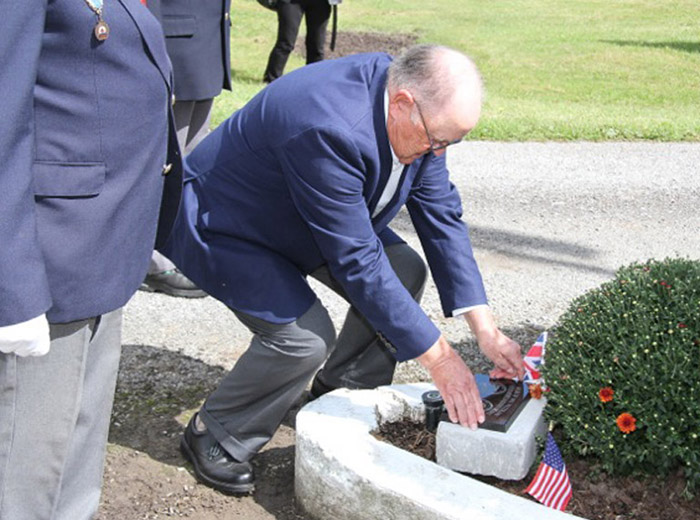Research compiled by the Heritage Arts Legacy of Fort Erie
In 1932, while excavations were underway for a new house along the river road at Fort Erie, the remains of two men were found. They were, after some difficulty, identified as an Officer in the King’s Regiment and a soldier from the US army, using buttons that had survived time. It was decided that a memorial should be erected in honour of these two fallen soldiers.
 The public-spirited people of patriotic Fort Erie provided the money for a memorial to be located on the rise in Greenwood Cemetery in the form of a flagstaff and two memorial plates. The legionnaires of Fort Erie and Buffalo were in full support of giving these two soldiers an honoured burial. The old King’s Regiment was now the Toronto Regiment and whole-heartedly agreed to participate in the proceedings.
The public-spirited people of patriotic Fort Erie provided the money for a memorial to be located on the rise in Greenwood Cemetery in the form of a flagstaff and two memorial plates. The legionnaires of Fort Erie and Buffalo were in full support of giving these two soldiers an honoured burial. The old King’s Regiment was now the Toronto Regiment and whole-heartedly agreed to participate in the proceedings.
Arriving at Queenston, the Toronto Regiment and their bands were taken to Fort Erie by motorcade along the same Niagara River that 120 years earlier had been the route of Isaac Brock and his men as they brought guns and ammunition to Old Fort Erie. The American Legion detachment and their band also joined the proceedings, along with Girl Guides, Boy Scouts and Highland Pipers to complete the parade to Greenwood Cemetery. On the way to the cemetery, the march was broken long enough for the placing of wreaths at the war memorial at Fort Erie City Hall. Hundreds of people joined the dedication ceremony.
 The American Legion performed their dedication ceremony at Greenwood for their fallen soldier and followed by the ceremony by the Toronto Regiment for the unknown Officer of the King’s Regiment. Both dedication ceremonies were carried out with careful observance of military traditions of both nations. Religious exercises were conducted by a Canadian Military Chaplain, by a Minister of the United Church, by a Rector of the Anglican Church and a Roman Catholic Priest from Buffalo.
The American Legion performed their dedication ceremony at Greenwood for their fallen soldier and followed by the ceremony by the Toronto Regiment for the unknown Officer of the King’s Regiment. Both dedication ceremonies were carried out with careful observance of military traditions of both nations. Religious exercises were conducted by a Canadian Military Chaplain, by a Minister of the United Church, by a Rector of the Anglican Church and a Roman Catholic Priest from Buffalo.
Linking the present with the past, a mother who had lost her son in WW1, dressed in black and wearing her son’s medals, including the Victoria Cross, stepped forward at the appropriate time to unveil the plaques. She was the mother of Lieutenant Lewis Honey of the 78th Battalion who lost his life in the Battle of Bourion Wood, twice capturing enemy positions, dying in action. The Victoria Cross was given to his mother by the Prince of Wales.
This ceremony to rebury and honour these two fallen soldiers was reported in the Toronto Mail and Empire by Fred Williams and in the New York Times on 11 Sept 1932.

